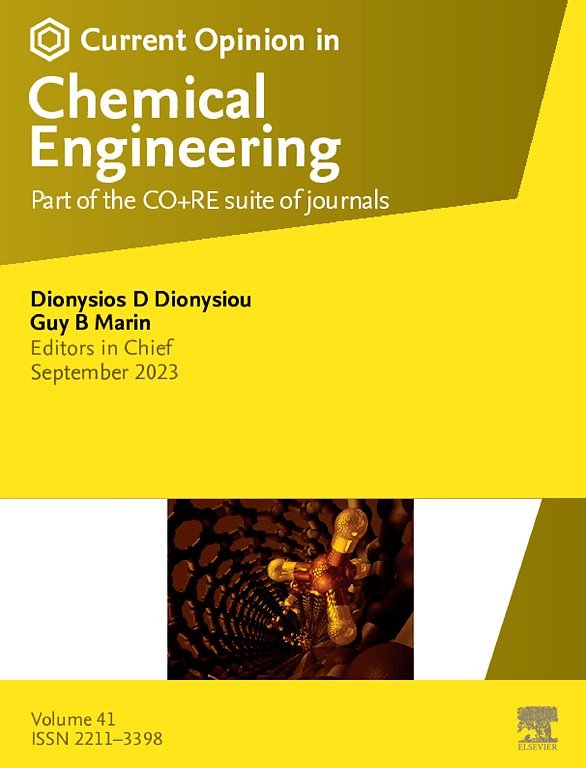Role of dynamic gravity in marinized multiphase packed bed applications
IF 6.8
2区 工程技术
Q1 BIOTECHNOLOGY & APPLIED MICROBIOLOGY
引用次数: 0
Abstract
Innovative, energy-efficient technologies for the capture and conversion of CO2 from marine emissions offer a promising path to reducing CO2 emissions in a circular economy. This emerging research area envisions CO2 capture and conversion in multiphase packed columns and trickle beds on ships and floating production, storage, and offloading units. However, the associated marine environments, characterized by instability and motions, such as tilting, rolling, and heaving, disrupt fluid dynamics, mass transfer, and reaction performance. This contribution examines recent advances in modeling fluid dynamics in (random/structured) packed columns and trickle beds under simulated marine conditions and highlights the role of dynamic gravity in these marinized multiphase packed bed applications. Using transient three-dimensional Computational Fluid Dynamics CFD modeling and simulation, this work explores the effects of tilt angle, heave, and roll motion parameters to quantitatively address the influence of changing sea/ocean conditions. It attempts to shed light on the design and operation of marine/offshore unit operations. Of particular interest is the study's focus on the multiphase flow hydrodynamics under dynamic gravitational forces (high to zero gravity in radial/azimuthal directions or high to low gravity in axial direction of porous medium), resulting in unique patterns, such as axial asymmetric two-phase flows and oscillatory two-phase flows.
动态重力在海水化多相填料床应用中的作用
从海洋排放中捕获和转化二氧化碳的创新、节能技术为在循环经济中减少二氧化碳排放提供了一条有希望的途径。这个新兴的研究领域设想在船舶和浮式生产、储存和卸载装置上的多相填料柱和涓滴床上进行二氧化碳捕获和转化。然而,相关的海洋环境以不稳定性和运动为特征,如倾斜、滚动和起伏,破坏了流体动力学、传质和反应性能。本文研究了模拟海洋条件下(随机/结构化)填料柱和细流床流体动力学建模的最新进展,并强调了动态重力在这些海水化多相填料床应用中的作用。利用瞬态三维计算流体动力学CFD建模和仿真,本研究探讨了倾斜角度、升沉和侧滚运动参数的影响,以定量地解决海洋条件变化的影响。它试图阐明海洋/海上装置作业的设计和操作。特别令人感兴趣的是,该研究的重点是动态重力作用下的多相流流体动力学(径向/方位方向从高到零重力或多孔介质轴向从高到低重力),产生了独特的模式,如轴向不对称两相流和振荡两相流。
本文章由计算机程序翻译,如有差异,请以英文原文为准。
求助全文
约1分钟内获得全文
求助全文
来源期刊

Current Opinion in Chemical Engineering
BIOTECHNOLOGY & APPLIED MICROBIOLOGYENGINE-ENGINEERING, CHEMICAL
CiteScore
12.80
自引率
3.00%
发文量
114
期刊介绍:
Current Opinion in Chemical Engineering is devoted to bringing forth short and focused review articles written by experts on current advances in different areas of chemical engineering. Only invited review articles will be published.
The goals of each review article in Current Opinion in Chemical Engineering are:
1. To acquaint the reader/researcher with the most important recent papers in the given topic.
2. To provide the reader with the views/opinions of the expert in each topic.
The reviews are short (about 2500 words or 5-10 printed pages with figures) and serve as an invaluable source of information for researchers, teachers, professionals and students. The reviews also aim to stimulate exchange of ideas among experts.
Themed sections:
Each review will focus on particular aspects of one of the following themed sections of chemical engineering:
1. Nanotechnology
2. Energy and environmental engineering
3. Biotechnology and bioprocess engineering
4. Biological engineering (covering tissue engineering, regenerative medicine, drug delivery)
5. Separation engineering (covering membrane technologies, adsorbents, desalination, distillation etc.)
6. Materials engineering (covering biomaterials, inorganic especially ceramic materials, nanostructured materials).
7. Process systems engineering
8. Reaction engineering and catalysis.
 求助内容:
求助内容: 应助结果提醒方式:
应助结果提醒方式:


